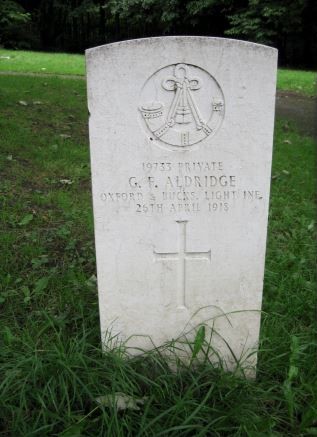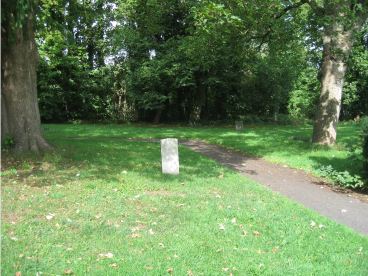2nd Battalion, Oxfordshire & Buckinghamshire Light Infantry

George Frederick Aldridge was born at Henley-onThames, Oxfordshire in 1886. He was the son of Henry (a farm labourer) and his wife Jane (née Tranter); the couple had married in 1868 and produced nine children, seven boys and two girls. Henry died in 1891, aged 53 and Jane in 1914, aged 65.
George was a labourer when he attested for military service ‘for the duration of the war’ on 17 September 1915, aged 29. His address was stated to be West Street, Henley. He gave his marital status as ‘single’ and oddly, although he had eight siblings, he chose not to list any next of kin.
Having reported to the Oxfordshire & Buckinghamshire Light Infantry Depot at Caversham George was posted to the 3rd (Reserve) Battalion on 23 September 1915.
After initial training he was posted to the 2nd Battalion (5 Brigade, 2 Division) on 17 December 1915 and was sent to France. Fortunately at least part of his service and pension records have survived, which does give us quite a lot of insight into his army service and after.
Soon after arriving in France he was in trouble at Rouen on 27 December 1915 for having deficient kit whilst on active service. He was required to replace the missing items from his own pocket. On 2 January 1916 he arrived at the Front, in the Bethune area and on 8 May in that year he sustained a gunshot wound to the neck and was treated initially at No 6 Field Ambulance. He was passed on to 23 Casualty Clearing Station on 10 May and on the 14 May he was admitted to 2nd General Hospital, Le Treport. Following treatment he was released to 2nd Infantry Base Depot at Rouen.
Perhaps as a form of rehabilitation from 19 August to 17 September George was assigned to 252 (?) Company Royal Engineers before re-joining the 2nd Oxfordshire & Buckinghamshire Light Infantry. On 24 September 1916 he was back at No 6 Field Ambulance, suffering from ‘debility’, re- joining his unit on the 29th.
On 24 October George was back at No 6 Field Ambulance once again, this time the reason being given as ‘NYD Mental’ – possible this translates as ‘not yet determined; mental illness’. The Field Ambulance transferred him, on the same day, to 29 Casualty Clearing Station at Gezaincourt and then to No 8 Stationery Hospital, Wimereux.
There it was confirmed that George was a mental illness case and he stayed at Wimereux until 19 November 1916, when he was transferred back to the UK aboard the Hospital Ship Western Australia, arriving at Netley Hospital on 20 November. Subsequently he was transferred to Lord Derby’s War Hospital, Warrington.
On 7 February 1917 he was examined by a medical board, who diagnosed ‘dementia praecox’ (early signs of dementia). The board noted that Private Aldridge had been ‘much under fire and wounded in the neck’ and was ‘dull, listless and apathetic, with little interest in surroundings and a faulty memory’. There was a hint in the report of previous mental issues, prior to the war. The board considered his present condition to be the result of active service due to stress of the campaign. He was granted a total incapacity pension and discharged from the Army on 28 February 1917 — ‘no longer physically fit for war service’ — and received a Silver War Badge, to indicate he was a discharged serviceman.
At the time of discharge his address was stated to be Central Coffee Tavern, High Street, Cheltenham. How, why and when he arrived in Gloucestershire is not known. His pension records subsequently note that on 25 July 1917 he was an inmate of the County Asylum, Gloucester — this could have been either the institution in Horton Road or at Coney Hill.
George Aldridge died in the Asylum on 26 April 1918, age 31; according to his Pension Record Card the cause of death was Dementia. Having no declared next of kin his funeral was only attended by a few wounded soldiers from the asylum. For reasons unknown the asylum failed to inform the local military authorities of his death and he was buried in the equivalent of a pauper’s grave.
The story emerged in the pages of the patriotic magazine John Bull and this caused great upset in Gloucester. On 13 July 1918 the Gloucester Special Fund for Soldiers, Sailors and Dependents wrote to the military authorities in Gloucester, seeking permission to erect a memorial stone over the grave, a substantial sum of money having been raised by the public to cover the cost. They stated that ‘this man appears to be friendless’. The City of Gloucester Local Committee of the Naval & Military War Pensions Act 1915 (based at 9 Brunswick Road) wrote to the Oxfordshire & Buckinghamshire Regimental Records Office to determine details of George’s length of service and cause of discharge from the Army. It confirmed that he had died in a ‘lunatic asylum’ and had been buried in a pauper’s grave. They sought his address at time of discharge and believed him to be a ‘native of Cheltenham’.
On Saturday, 21 September 1918 the Mayor of Gloucester unveiled a memorial stone over George Aldridge’s grave, as part of a ceremony reported widely in the local papers. One of the several dignitaries stated that ‘Private George Frederick Aldridge was a brave British soldier who fought for his country and died in an institution … and was buried under circumstances which moved citizens to indignation.’
The memorial was in the form of a stone cross with the inscription: In honoured memory of a gallant British soldier, 19733 Private George Frederick Aldridge, 2nd Battalion Oxford & Bucks LI, BEF, died April 26th 1918 age 31 years. This stone was erected by the citizens of Gloucester.
The stone memorial is no longer present and the grave, which is located in an isolated position, is now marked by a standard CWGC headstone. In January 1922 the (then) Imperial War Graves Commission sought verification of the circumstances of death and erection of the memorial. It is likely that upon receipt the grave was accepted as a war grave, to be maintained in perpetuity.
There is a rather touching adjunct to this story. In its 8 February 1937 edition the Gloucester Citizen reported how a twelve year old girl (Margery Curtis) had ‘adopted’ the grave, visiting it each week to keep it tidy and plant flowers. She had remembered the line ‘we will remember them’ from remembrance services at school and when visiting her grandmother’s grave had noticed that Private Aldridge’s grave was now neglected, overgrown with grass and weeds and appeared to have been forgotten. She restored it to a tidy state and adorned it with flowers.
The local branch of the British Legion sought to contact relatives of Private Aldridge, via the War
Office but to no avail.

Researched by Graham Adams 19 January 2017
